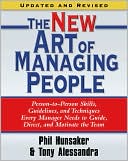List Books » The New Art of Managing People: Person-to-Person Skills, Guidelines, and Techniques Every Manager Needs to Guide, Direct, and Motivate the Team
Category Books
- Fiction Books & Literature
- Graphic Novels
- Horror
- Mystery & Crime
- Poetry
- Romance Books
- Science Fiction & Fantasy
- Thrillers
- Westerns
- Ages 0-2
- Ages 3-5
- Ages 6-8
- Ages 9-12
- Teens
- Children's Books
- African Americans
- Antiques & Collectibles
- Art, Architecture & Photography
- Bibles & Bible Studies
- Biography
- Business Books
- Christianity
- Computer Books & Technology Books
- Cookbooks, Food & Wine
- Crafts & Hobbies Books
- Education & Teaching
- Engineering
- Entertainment
- Foreign Languages
- Game Books
- Gay & Lesbian
- Health Books, Diet & Fitness Books
- History
- Home & Garden
- Humor Books
- Judaism & Judaica
- Law
- Medical Books
- New Age & Spirituality
- Nonfiction
- Parenting & Family
- Pets
- Philosophy
- Political Books & Current Events Books
- Psychology & Psychotherapy
- Reference
- Religion Books
- Science & Nature
- Self Improvement
- Sex & Relationships
- Social Sciences
- Sports & Adventure
- Study Guides & Test Prep
- Travel
- True Crime
- Weddings
- Women's Studies
The New Art of Managing People: Person-to-Person Skills, Guidelines, and Techniques Every Manager Needs to Guide, Direct, and Motivate the Team » (Revised)

Authors: Phillip L. Hunsaker, Anthony J. Alessandra
ISBN-13: 9781416550624, ISBN-10: 1416550623
Format: Paperback
Publisher: Simon & Schuster Adult Publishing Group
Date Published: December 2008
Edition: Revised
Author Biography: Phillip L. Hunsaker
Tony Alessandra has a streetwise, college-smart perspective on business, having realized success as a former graduate professor of marketing, Internet entrepreneur, business author, and keynote speaker. He is the author of seventeen books, including Charisma and The Platinum Rule.
Phil Hunsaker is a researcher, teacher, author, and consultant in the areas of personal, interpersonal, team, and organizational effectiveness. He has authored more than 100 articles and eleven books, including Management and Organizational Behavior and Training in Interpersonal Skills.
Book Synopsis
When a manager establishes a friendly yet productive working atmosphere, the benefits to the whole organization are substantial. The Art of Managing People provides practical strategies, guidelines and techniques for
* Developing the interpersonal skills necessary to improve relations with employees
* Understanding the differences between people, and behaving accordingly
* Assessing, and then improving, current working situations
* Creating trust between managers and employees.
Person-to-person skills are the key to developing an effective team of satisfied, energetic workers. Letting your workers express their own personalities and maximize their potentials will
* Reduce stress within the work force,
* Create a positive spirit throughout the company, and
* Increase the organization's productivity and profitability.
Table of Contents
Contents
Preface
1 Building Productive Managerial Relationships
The Interactive Approach to Managing People Principles of Interactive Management Increasing Employees' On-The-Job Effectiveness Understanding People Interactive Communication Skills Constructive Manipulation What to Expect
ADJUSTING EFFECTIVELY TO PERSONAL STYLE DIFFERENCES
2 Learning How to Learn
The Learning Model Dimensions of Learning Individual Learning Styles Learning Modes Learning Style Types Characteristics of Learning Style Types Learning Styles and Problem Solving Guidelines for Managing the Learning Process
3 Doing Unto Others
Behavioral Styles and Interpersonal Problems Unproductive Behavior Identifying Behavioral Styles Behavioral Flexibility Behavioral Styles and Interactive Management
4 Deciding How to Decide
The Dimensions of Decision Style Four Basic Decision Styles Back-Up Styles Mixed Styles Characteristics of Each Decision Style Is There a "Best" Decision Style?
Advantages of Each Style Problems of Each Style Coping Productively with Other Styles Applications to Integrative Management
5 Analyzing Transactional Styles
Ego States Transactions Strokes Life Positions Trading Stamps Use of Time Games Stopping Games Interventions TA and Interactive Management
INTERACTIVE COMMUNICATION SKILLS
6 The Art of Questioning
Why People Ask Questions Types of Questions Questioning Strategies and Techniques
7 The Power of Listening
Gripes about Managers Categories of Listeners Barriers to Effective Listening The Nineteen Commandments of Power Listening Exercises to Improve Your Listening SkillsListening and Interactive Management
8 Projecting the Appropriate Image
Components of Image Image and Interactive Management
9 Communicating Through Voice Tones
10 Using Body Language Effectively
Interpreting Body Language Gestures Interpreting Gesture Clusters Using Body Language
11 Spatial Arrangements Say Things
Territory Environment Things Using Territory and Environment to Facilitate Communication Personal Space Interpersonal Space Interpersonal Space Strategies Special Arrangement Determinants Implications for Interactive Management
12 How Your Use of Time Talks
Accuracy Scarcity Repetition
13 Making Sure with Feedback
Types of Feedback Using Feedback Effectively
INTERACTIVE PROBLEM-SOLVING
14 Problem-Solving Together
Problem Definition Action Planning Implementation Follow-Through
15 Defining the Problem
Step 1: Establish Trust Bond Step 2: Clarify Objectives Step 3: Assess Current Situation Step 4: Identify Problems Step 5: Define and Analyze Problems Step 6: Agree on Problems to be Solved
16 Developing Action Plans
Step 1: Check the Trust Bond Step 2: Establish Decision-Making Criteria Step 3: Develop Action Alternatives Step 4: Evaluate Action Alternatives Step 5: Decide on an Action Plan
17 Implementing Action
Step 1: Check the Trust Bond Step 2: Assign Tasks and Responsibilities Step 3: Set Up an Implementation Schedule Step 4: Reinforce Commitment and Activate
18 Following Through
Step 1: Check the Trust Bond Step 2: Establish Criteria for Success Step 3: Determine How to Measure Performance Step 4: Monitor Results Step 5: Take Corrective Action
19 What Do You Do with What You've Learned?
Use the Interactive Management Problem-Solving Process to Improve Your Interactive Management Skills Index
Subjects

